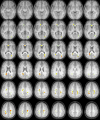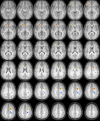Diffusion tensor imaging reveals white matter microstructure correlations with auditory processing ability
- PMID: 21063207
- PMCID: PMC3057932
- DOI: 10.1097/AUD.0b013e3181f7a481
Diffusion tensor imaging reveals white matter microstructure correlations with auditory processing ability
Abstract
Objective: Correlation of white matter microstructure with various cognitive processing tasks and with overall intelligence has been previously demonstrated. We investigate the correlation of white matter microstructure with various higher-order auditory processing tasks, including interpretation of speech-in-noise, recognition of low-pass frequency filtered words, and interpretation of time-compressed sentences at two different values of compression. These tests are typically used to diagnose auditory processing disorder (APD) in children. Our hypothesis is that correlations between white matter microstructure in tracts connecting the temporal, frontal, and parietal lobes, as well as callosal pathways, will be seen. Previous functional imaging studies have shown correlations between activation in temporal, frontal, and parietal regions from higher-order auditory processing tasks. In addition, we hypothesize that the regions displaying correlations will vary according to the task because each task uses a different set of skills.
Design: Diffusion tensor imaging (DTI) data were acquired from a cohort of 17 normal-hearing children aged 9 to 11 yrs. Fractional anisotropy (FA), a measure of white matter fiber tract integrity and organization, was computed and correlated on a voxelwise basis with performance on the auditory processing tasks, controlling for age, sex, and full-scale IQ.
Results: Divergent correlations of white matter FA depending on the particular auditory processing task were found. Positive correlations were found between FA and speech-in-noise in white matter adjoining prefrontal areas and between FA and filtered words in the corpus callosum. Regions exhibiting correlations with time-compressed sentences varied depending on the degree of compression: the greater degree of compression (with the greatest difficulty) resulted in correlations in white matter adjoining prefrontal (dorsal and ventral), whereas the smaller degree of compression (with less difficulty) resulted in correlations in white matter adjoining audiovisual association areas and the posterior cingulate. Only the time-compressed sentences with the lowest degree of compression resulted in positive correlations in the centrum semiovale; all the other tasks resulted in negative correlations.
Conclusions: The dependence of performance on higher-order auditory processing tasks on brain anatomical connectivity was seen in normal-hearing children aged 9 to 11 yrs. Results support a previously hypothesized dual-stream (dorsal and ventral) model of auditory processing, and that higher-order processing tasks rely less on the dorsal stream related to articulatory networks and more on the ventral stream related to semantic comprehension. Results also show that the regions correlating with auditory processing vary according to the specific task, indicating that the neurological bases for the various tests used to diagnose APD in children may be partially independent.
Figures




Similar articles
-
Altered white matter microstructure underlies listening difficulties in children suspected of auditory processing disorders: a DTI study.Brain Behav. 2014 Jul;4(4):531-43. doi: 10.1002/brb3.237. Epub 2014 May 29. Brain Behav. 2014. PMID: 25161820 Free PMC article.
-
White matter microstructural differences linked to left perisylvian language network in children with dyslexia.Cortex. 2010 Jun;46(6):739-49. doi: 10.1016/j.cortex.2009.07.008. Epub 2009 Jul 22. Cortex. 2010. PMID: 19682675 Free PMC article.
-
Executive deficits, not processing speed relates to abnormalities in distinct prefrontal tracts in amyotrophic lateral sclerosis.Brain. 2013 Nov;136(Pt 11):3290-304. doi: 10.1093/brain/awt243. Epub 2013 Sep 20. Brain. 2013. PMID: 24056536
-
Disentangling the relation between left temporoparietal white matter and reading: A spherical deconvolution tractography study.Hum Brain Mapp. 2015 Aug;36(8):3273-87. doi: 10.1002/hbm.22848. Epub 2015 Jun 3. Hum Brain Mapp. 2015. PMID: 26037303 Free PMC article.
-
White matter microstructure correlates of mathematical giftedness and intelligence quotient.Hum Brain Mapp. 2014 Jun;35(6):2619-31. doi: 10.1002/hbm.22355. Epub 2013 Sep 3. Hum Brain Mapp. 2014. PMID: 24038774 Free PMC article.
Cited by
-
Altered structural connectome of children with auditory processing disorder: a diffusion MRI study.Cereb Cortex. 2023 Jun 8;33(12):7727-7740. doi: 10.1093/cercor/bhad075. Cereb Cortex. 2023. PMID: 36928480 Free PMC article.
-
White Matter Microstructure is Associated with Auditory and Tactile Processing in Children with and without Sensory Processing Disorder.Front Neuroanat. 2016 Jan 26;9:169. doi: 10.3389/fnana.2015.00169. eCollection 2015. Front Neuroanat. 2016. PMID: 26858611 Free PMC article.
-
Brain structure correlates with auditory function in children diagnosed with auditory neuropathy spectrum disorder.Brain Behav. 2022 Nov;12(11):e2773. doi: 10.1002/brb3.2773. Epub 2022 Oct 3. Brain Behav. 2022. PMID: 36184939 Free PMC article.
-
Abnormal Resting-State Quantitative Electroencephalogram in Children With Central Auditory Processing Disorder: A Pilot Study.Front Neurosci. 2018 May 11;12:292. doi: 10.3389/fnins.2018.00292. eCollection 2018. Front Neurosci. 2018. PMID: 29867312 Free PMC article.
-
Dichotic listening deficits in amblyaudia are characterized by aberrant neural oscillations in auditory cortex.Clin Neurophysiol. 2021 Sep;132(9):2152-2162. doi: 10.1016/j.clinph.2021.04.022. Epub 2021 Jun 4. Clin Neurophysiol. 2021. PMID: 34284251 Free PMC article.
References
-
- Avan P, Bonfils P. Analysis of possible interactions of an attentional task with cochlear mechanics. Hearing Research. 1991;57:269–275. - PubMed
-
- Basser PJ, Jones DK. Diffusion-tensor MRI: theory, experimental design and data analysis - a technical review. NMR Biomed. 2002;15(7-8):456–467. - PubMed
-
- Beasley DS, Freeman BA. Time altered speech as a measure of central auditory processing. In: Keith RW, editor. Central Auditory Dysfunction. New York: Grune and Stratton; 1977.
-
- Bench J, Kowal A, Bamford J. The BKB (Bamford-Kowal-Bench) Sentence Lists for Partially-Hearing Children. Br J Audiol. 1979;13:108–112. - PubMed
-
- Boemio A, Fromm S, Braun A, Poeppel D. Hierarchical and asymmetric temporal sensitivity in human auditory cortices. Nat Neurosci. 2005;8(3):389–395. - PubMed
Publication types
MeSH terms
Grants and funding
LinkOut - more resources
Full Text Sources

